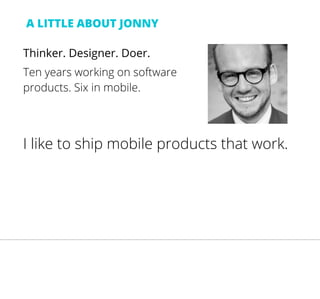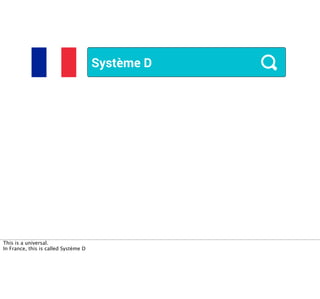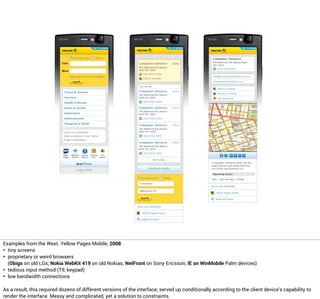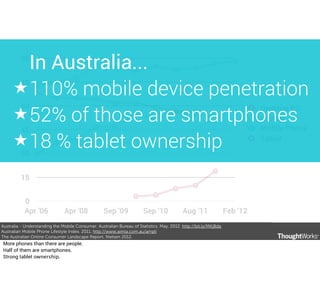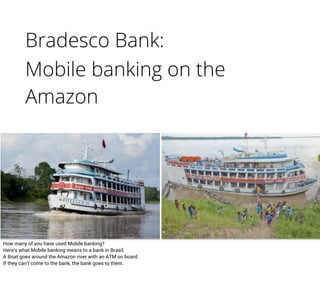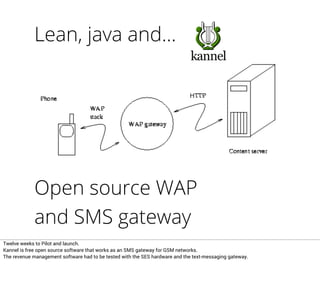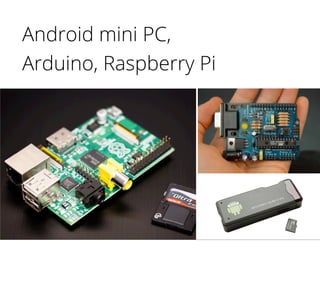Designing Mobile Solutions for Social & Economic Contexts
- 1. MORE THAN JUST AN APP Designing Mobile Solutions for Social & Economic Contexts Bangalore, India 9 October 2013 We’re from ThoughtWorks, and we’re here to talk about how mobile can solve unique problems in meaningful ways in different social contexts.
- 2. A LITTLE ABOUT JONNY Thinker. Designer. Doer. Ten years working on software products. Six in mobile. I like to ship mobile products that work.
- 3. A BIT ABOUT NAG VP Global South Strategy. Involved in mobile since 2002, starting with the Simputer project.
- 4. 1. What is design? 2. Social context in the West. 3. Social context in the Global South. 4. The coming Ubi-Comp revolution. 5. Thinking like a designer. WE’RE GOING TO TALK ABOUT...
- 5. What is design, exactly? Jonny, on design.
- 6. A process of creating order from chaos. Combining disjointed parts into something complete and cohesive. From disintegrated to integrated. By doing this we enhance order, purpose and meaning of a thing.
- 7. A solution to a problem, within a set of constraints. Go beyond cohesive integration. It must be useful. As a user, you have needs to be met. A solution must meet those needs in context to my environment and it’s constraints.
- 8. • Architects design living environments within the constraints of space and material • Civil engineers design infrastructure within the constraints of material • Advertising graphic designers design communication within the constraints of media • City planners design public transport services within the constraints of traffic and infrastructure A FEW DIFFERENT FLAVOURS
- 9. Mobile product designers solve problems for people within the constraints of business and technology.
- 10. User Centred Design (desirability) Technology (feasibility) Business (viability) Product Innovation Consider ALL the parts Where Business & Technology meet (like in big business), often the user experience suffers. When Business & Design is the focus (like in advertising), solutions might not be feasible or efficient With Design & Technology (as in startups), it’s often viability that suffers
- 11. TECHNOLOGY BUSINESS USER NEEDS CONVENTIONS feasibility hardware browsers network access input methods display technology bandwidth viability time budget/cost capabilities revenue model demand resources desirability proposition unmet needs value goals design principles guidelines interaction models patterns style guides A snapshot of some constraints and considerations
- 12. Embrace constraints “When forced to work within a strict framework the imagination is taxed to its utmost - and will produce its richest ideas. Given total freedom the work is likely to sprawl.” -T.S. Eliot T.S. Eliot was an American publisher and playwright in the 1880’s He understood the importance of embracing constraints. He’s saying that without constraint, the work suffers, and with constraint, the mind is at it’s most creative.
- 13. Jugaad Work it out yourself, with whatever you’ve got. The indian word Jugaad means an improvisation or work around, which is necessary because of lack of resources. Improvisation ≠ design, but the same creativity that embraces constraint is necessary for good design.
- 14. Système D This is a universal. In France, this is called Système D
- 15. Jietinho In Brazil, it’s Jietinho
- 16. Zizhu Chuangxin And China has Zizhu Chuangxin
- 17. A few examples of overcoming constraints from the Global South... Indian cappuccino machine made from a pressure cooker.
- 18. African mobile phone charger ...We will see a little later why this is such a big deal
- 19. Filipino light bulb. That’s a water bottle refracting light through a hole in a tin roof.
- 20. Examples from the West. Yellow Pages Mobile, 2008 • tiny screens • proprietary or weird browsers (Obigo on old LGs; Nokia WebKit 419 on old Nokias; NetFront on Sony Ericsson, IE on WinMobile Palm devices) • tedious input method (T9, keypad) • low bandwidth connections As a result, this required dozens of different versions of the interface, served up conditionally according to the client device’s capability to render the interface. Messy and complicated, yet a solution to constraints.
- 21. NAB Mobile Banking apps, 2010-11 • 15 Year old infrastructure and systems • No APIs • very aggressive budgets • Extremely high level of security required meant a lot of technical complexity Quite a lot of improvisation required to create the perception of simplicity for users.
- 22. NAB Mobile Banking apps, 2010-11 • 15 Year old infrastructure and systems • No APIs • very aggressive budgets • Extremely high level of security required meant a lot of technical complexity Quite a lot of improvisation required to create the perception of simplicity for users.
- 23. https://speakerdeck.com/jonnyschneider Natural language banking prototype, 2012 ‘Siri for banking’ • latency • the nuance of human linguistics (machine understanding) • multi-modal interactions There’s an entire talk on this, if you want more detail on that
- 24. Social context awareness is as important as technical ability.
- 25. Do RIGHT Things Build Things RIGHT Build RIGHT things You are probably great at this part This requires enquiry, insight and vision Building the right thing not just building the thing right. Software quality. Engineering excellence. Performant architecture. None of those things mean anything if no one uses your product.
- 26. Focus on proposition (don’t be a hammer looking for a nail) Ask yourself: • What problem is being solved? • How will technology help to solve the problem? • How will it maintain business viability?
- 27. HIERARCHY OF NEEDS usable reliable functional desirable ‘Designing for Emotion’, Aarron Walter, A Book Apart. A remap of Maslow’s hierarchy of needs, for products and services. The goal (for the west) is often ‘desirable’. I don’t need it, but I want it. We can do this by making an emotional connection with customers, to elicit a choice or preference to use the product. It’s more than just getting a task done.
- 28. DESIRABLE: MORE THAN JUST ‘USABLE’ An example if clever emotional design. Any.do Ostensibly, it’s just like every other task manager - It has a list of tasks, some are done, some aren’t. Then it gets personal. It knows my name... ‘Any.do Moment’ helps me every morning to reduce the noise dozens of items down to 2-3 most important things This makes me feel better about my day
- 29. DESIRABLE: MORE THAN JUST ‘USABLE’ An example if clever emotional design. Any.do Ostensibly, it’s just like every other task manager - It has a list of tasks, some are done, some aren’t. Then it gets personal. It knows my name... ‘Any.do Moment’ helps me every morning to reduce the noise dozens of items down to 2-3 most important things This makes me feel better about my day
- 30. DESIRABLE: MORE THAN JUST ‘USABLE’ An example if clever emotional design. Any.do Ostensibly, it’s just like every other task manager - It has a list of tasks, some are done, some aren’t. Then it gets personal. It knows my name... ‘Any.do Moment’ helps me every morning to reduce the noise dozens of items down to 2-3 most important things This makes me feel better about my day
- 31. DESIRABLE: MORE THAN JUST ‘USABLE’ An example if clever emotional design. Any.do Ostensibly, it’s just like every other task manager - It has a list of tasks, some are done, some aren’t. Then it gets personal. It knows my name... ‘Any.do Moment’ helps me every morning to reduce the noise dozens of items down to 2-3 most important things This makes me feel better about my day
- 32. DESIRABLE: MORE THAN JUST ‘USABLE’ An example if clever emotional design. Any.do Ostensibly, it’s just like every other task manager - It has a list of tasks, some are done, some aren’t. Then it gets personal. It knows my name... ‘Any.do Moment’ helps me every morning to reduce the noise dozens of items down to 2-3 most important things This makes me feel better about my day
- 33. DESIRABLE: MORE THAN JUST ‘USABLE’ An example if clever emotional design. Any.do Ostensibly, it’s just like every other task manager - It has a list of tasks, some are done, some aren’t. Then it gets personal. It knows my name... ‘Any.do Moment’ helps me every morning to reduce the noise dozens of items down to 2-3 most important things This makes me feel better about my day
- 34. THE WORLD ECONOMIC PYRAMID Annual income Tier Population $20,000+ ($60/day) 1 0.10 Billion $1,500-20,000 2 + 3 1.5-1.75 Billion < $1,500 ($4.10/day) 4 4 Billion For now, just remember the top of the pyramid. More than $20,000 income per year One tenth of a billion people (only 1.4% of global population, 7 Billion)
- 35. Social context in the West Jonny, on social context in developed economies.
- 36. Pew Research, 2012. http://pewinternet.org/Reports/2012/Digital-differences/Main-Report/Internet-adoption-over-time.aspx 0 20 40 60 80 ‘95 ‘96 ‘97 ‘98 ‘99 ‘00 ‘00 ‘01 ‘02 ‘03 ‘04 ‘05 ‘06 ‘07 ‘08 ‘09 ‘10 ‘11 Internet adoption over time (percentage American adults) Most people have access to the internet.
- 37. The Australian Online Consumer Landscape Report, Nielsen 2012. 0 20 40 60 80 ‘95 ‘96 ‘97 ‘98 ‘99 ‘00 ‘00 ‘01 ‘02 ‘03 ‘04 ‘05 ‘06 ‘07 ‘08 ‘09 ‘10 ‘11 Internet adoption over time (percentage American adults) 82% of Australian adults are online in 2012 It’s the same in Australia.
- 38. Pew Research Center, 2012. http://pewinternet.org/Reports/2012/Digital-differences/Main-Report/The-power-of-mobile.aspx 0 15 30 45 60 75 90 Apr ‘06 Apr ‘08 Sep ‘09 Sep ‘10 Aug ‘11 Feb ‘12 Desktop PC Laptop Mobile Phone Tablet Adult gadget ownership over time This isn’t a new story. Mobile ownership is approaching saturation. Tablet ownership on the rise.
- 39. Australia - Understanding the Mobile Consumer. Australian Bureau of Statistics. May, 2012. http://bit.ly/MKj8dq Australian Mobile Phone Lifestyle Index. 2011. http://www.aimia.com.au/ampli The Australian Online Consumer Landscape Report, Nielsen 2012. 0 15 30 45 60 75 90 Apr ‘06 Apr ‘08 Sep ‘09 Sep ‘10 Aug ‘11 Feb ‘12 Desktop PC Laptop Mobile Phone Tablet In Australia... ★110% mobile device penetration ★52% of those are smartphones ★18 % tablet ownership More phones than there are people. Half of them are smartphones. Strong tablet ownership.
- 40. Data: http://isc.org; http://amta.org.au; http://wikipedia.org and various websites ‘87 ‘89 ‘91 ‘93 ‘95 ‘97 ‘99 ‘01 ‘03 ‘05 ‘07 ‘09 ‘11 AMPS Analogue GSM 2G/WAP/WML/i-mode 3G UMTS NextG total number of internet destinations A brief history lesson on the where, when and how of internet access. • Voice Era - all about voice • Feature Phone Era - starting to use the web • Smartphone Era - using the web a lot
- 41. Data: http://isc.org; http://amta.org.au; http://wikipedia.org and various websites ‘87 ‘89 ‘91 ‘93 ‘95 ‘97 ‘99 ‘01 ‘03 ‘05 ‘07 ‘09 ‘11 AMPS Analogue GSM 2G/WAP/WML/i-mode 3G UMTS NextG Telecom ‘Walkabout’ Motorola Brick SMS is born A brief history lesson on the where, when and how of internet access. • Voice Era - all about voice • Feature Phone Era - starting to use the web • Smartphone Era - using the web a lot
- 42. Data: http://isc.org; http://amta.org.au; http://wikipedia.org and various websites ‘87 ‘89 ‘91 ‘93 ‘95 ‘97 ‘99 ‘01 ‘03 ‘05 ‘07 ‘09 ‘11 AMPS Analogue GSM 2G/WAP/WML/i-mode 3G UMTS NextG Telecom ‘Walkabout’ Motorola Brick SMS is born Nokia 5110 Motorola RAZR Palm Treo 1st mobile web browsers 1st WebKit browser Predicti ve Text VOICE ERA A brief history lesson on the where, when and how of internet access. • Voice Era - all about voice • Feature Phone Era - starting to use the web • Smartphone Era - using the web a lot
- 43. Data: http://isc.org; http://amta.org.au; http://wikipedia.org and various websites ‘87 ‘89 ‘91 ‘93 ‘95 ‘97 ‘99 ‘01 ‘03 ‘05 ‘07 ‘09 ‘11 AMPS Analogue GSM 2G/WAP/WML/i-mode 3G UMTS NextG Telecom ‘Walkabout’ Motorola Brick SMS is born iPhone 3 HTC Dream (1st Android) iPad 1 Nokia 5110 Motorola RAZR Palm Treo 1st mobile web browsers 1st WebKit browser Predicti ve Text VOICE ERA FEATURE PHONE ERA A brief history lesson on the where, when and how of internet access. • Voice Era - all about voice • Feature Phone Era - starting to use the web • Smartphone Era - using the web a lot
- 44. Data: http://isc.org; http://amta.org.au; http://wikipedia.org and various websites ‘87 ‘89 ‘91 ‘93 ‘95 ‘97 ‘99 ‘01 ‘03 ‘05 ‘07 ‘09 ‘11 AMPS Analogue GSM 2G/WAP/WML/i-mode 3G UMTS NextG Telecom ‘Walkabout’ Motorola Brick SMS is born iPhone 3 HTC Dream (1st Android) iPad 1 Nokia 5110 Motorola RAZR Palm Treo 1st mobile web browsers 1st WebKit browser Predicti ve Text VOICE ERA FEATURE PHONE ERA SMART- PHONE ERA A brief history lesson on the where, when and how of internet access. • Voice Era - all about voice • Feature Phone Era - starting to use the web • Smartphone Era - using the web a lot
- 45. The mobile device landscape is now homogenised. • Windows Mobile is gone (replaced with Windows Phone) • Nokia is now Microsoft • BlackBerry now has WebKit • Android OEMs produce standardised(ish) hardware • Android + iOS + Windows is generally enough for native app • Samsung and iPhone dominate • High-end devices are affordable for most people
- 46. Devices are part an ecosystem of screens and physical interfaces. ‘The future of mobile is the end of the term “mobile”’. Andrew Keen. http://thenextweb.com/mobile/2012/11/21/what-is-the-future-of-mobile/ Mobile devices exist as part of an ecosystem. High expectations for seamless integration.
- 47. 1 2 + 3 4 usable reliable functional desirable Affluent people in a saturated market. NEEDS ECONOMICS The social context in the West is characterised by the two pyramids. • high usage • high expectations • highly competitive...(sometimes) *monopolies or duopolies are common in Australia, but that’s another story.
- 48. ‘Name of referenced work’, Author/source/URL, date. Mobile must go beyond just ‘mobile’. People expect integrated and seamless services, and there is usually a choice of product. An example from Australia’s leading real estate website: Search, browse and create a shortlist of properties in your lunch hour.
- 49. ‘Name of referenced work’, Author/source/URL, date. AirPlay or stream to SmartTV in the evening to discuss with your buying partner.
- 50. ‘Name of referenced work’, Author/source/URL, date. Plan your day with the mobile app to help you get around on weekend property inspections
- 51. Social context in the Global South Nag, on the Global South.
- 52. What mobile apps would be helpful for the base of the pyramid? During a social outreach program, we met a few fisherwomen. We asked if technology could do anything for them. They asked for a device which did two things: • find fish in the ocean - competitive advantage against big company trawlers. • warn against tsunamis and other extreme conditions Interesting problem, isn’t it? The components (sensors etc.) clearly existed. But we were stumped. How to go about designing and making the device? Our eyes were opened to a new dimension of mobility. We went on a journey to discover this dimension. Let me tell you that story...
- 53. Bradesco Bank: Mobile banking on the Amazon How many of you have used Mobile banking? Here’s what Mobile banking means to a bank in Brasil. A Boat goes around the Amazon river with an ATM on board. If they can’t come to the bank, the bank goes to them.
- 54. $15,000 portable $300,000 immobile GE China: Vscan GE China’s Vscan is perfect for rural Global South $300M in revenue in 5 years. In the end, exported to the west.
- 55. MOBILE CRM FOR INDIA ‘Missed call’ in India. This is at Bangalore airport. When we think of CRM, we’re usually thinking of Salesforce or similar. Missed call get’s the job done!
- 56. Nokia: Long battery, flashlight, FM Radio This low cost Nokia device has FM, torchlight and runs for a week on one charge. Can your smartphone say that? Flashlight is highly functional, and useful, given that electricity and therefore lighting is never guaranteed.
- 57. WHAT SHOULD WE FOCUS ON? Technically Interesting Socially Important Games Social media Advertising eHealth eLearning eAgriculture eGov We realised that the Mobile industry was largely focussed on the wrong problems. Games.
- 58. THE WORLD ECONOMIC PYRAMID Annual income Tier Population $20,000+ ($60/day) 1 0.10 Billion $1,500-20,000 2 + 3 1.5-1.75 Billion < $1,500 ($4.10/day) 4 4 Billion Most of the Global South is at the bottom of the World Economic Pyramid
- 59. usable reliable functional desirable NEEDS In that environment, functionality is inevitably a more important need than desirability.
- 60. http://apod.nasa.gov/apod/ap081005.html ACCESS TO ELECTRICITY Only about 4% of the population has access to grid power in Africa
- 61. http://apod.nasa.gov/apod/ap081005.html GSM NETWORK COVERAGE Around 98% of the population has access to mobile coverage
- 62. A MOBILE CHARGING STATION IN AFRICA
- 63. We looked at examples of a broader definition of mobility. We discovered a number of companies in other industries working on to the problem of how to make mobility relevant to the Global South. Here are some examples...
- 64. Simpa: Pay As You Go solar energy Founded 2010 in San Francisco as a for-profit social enterprise with a vision to bring clean and sustainable energy to nearly billion people living off the grid in the developing world. Their mission was to make clean solar energy affordable. Total expenditure for off-the-grid energy sources—such as kerosene or batteries—is quite high. Over a 10-year period, households spend $750- $1,500 on kerosene, candles, batteries, and phone charging—enough to pay for multiple high quality solar energy systems. But low- income families cannot afford to pay the entire $400 up-front cost of a high quality SES, and traditional lenders won’t lend to households without a dependable and steady income.
- 65. Total Cost of Ownership Flexibility of Payments Initial Purchase Price Progressive purchase Modeled on the familiar pay-as-you-go pricing model for prepaid mobile phone service. Customers pre-pay, in cash, to “recharge” at local agents. Agents use SMS to communicate purchases to Simpa, where the core revenue management software debits their account and sends back a usage code. The consumer later keys the code into their unit to receive the amount of power that was purchased. Top-ups also pay down the cost of the SES itself. When the cost is fully paid off, the SES unit is permanently unlocked and the energy generated is free.
- 66. Lean, java and... Open source WAP and SMS gateway Twelve weeks to Pilot and launch. Kannel is free open source software that works as an SMS gateway for GSM networks. The revenue management software had to be tested with the SES hardware and the text-messaging gateway.
- 67. mPedigree: fighting counterfeit drugs 67% of medicine sold is counterfeit SMS code to get response if medicine is counterfeit or not is a good enough solution Experts believe the counterfeit trade is worth about $700 billion a year. But it is the trade in fake medicines, in particular, that has raised the greatest alarm: nearly 2,000 people are estimated to die from falsified and sub-standard medicines yearly.
- 68. Farmer services in India
- 69. The coming UbiComp revolution Nag, on ubiquitous computing
- 70. Android mini PC, Arduino, Raspberry Pi
- 71. Arduino board, connected to hand-wash tap and GPRS unit Aggregated usage reports Monitoring usage of sanitation A prototype project for ThoughtWorks in collaboration with a global health organisation.
- 72. Pulse sensor with battery powered Arduino
- 73. • Agile/Lean Methods • Multi-disciplinary engineering • Being frugal and systems thinking • Ecosystems • Empathy and design SKILLS FOR RADICAL MOBILITY
- 74. Thinking like a designer Jonny, on thinking like a designer.
- 75. RL + Analytical Fact-driven Logical Good at planning Linear Management Planning Visual Intuitive Lateral Creative Visionary User Research Empathy People often think about Left OR Right brain thinking. Left AND Right brain is much more powerful. It’s a collaboration. Analytical & Intuitive Logical & Lateral Factual & Creative
- 76. DESIGN IS MORE THAN ABRACADABRA You don’t need to a magician to do design. Harness the power of the intelligence of others.
- 77. AND IT’S MORE THAN JUST DON DRAPER And it’s not about being a design hero either.
- 78. Everyone is a designer. Listen. Ask the right questions. Empathise. Synthesise meaning from insight. Interpret. Find a vision. Be a communicator.
- 79. User Centred Design (desirability) Technology (feasibility) Business (viability) Product Innovation A vision should encompass business, technology and users. Don’t settle for your first ‘good idea’ understand the problem to be solved more fully, generate lots of ideas and solutions. Work together to find the most robust and meaningful solutions.
- 80. You are a designer. Engineering is design. You are already doing design, even if you don’t know it.
- 81. Think about social and economic context for the products you make.
- 83. Work together.

